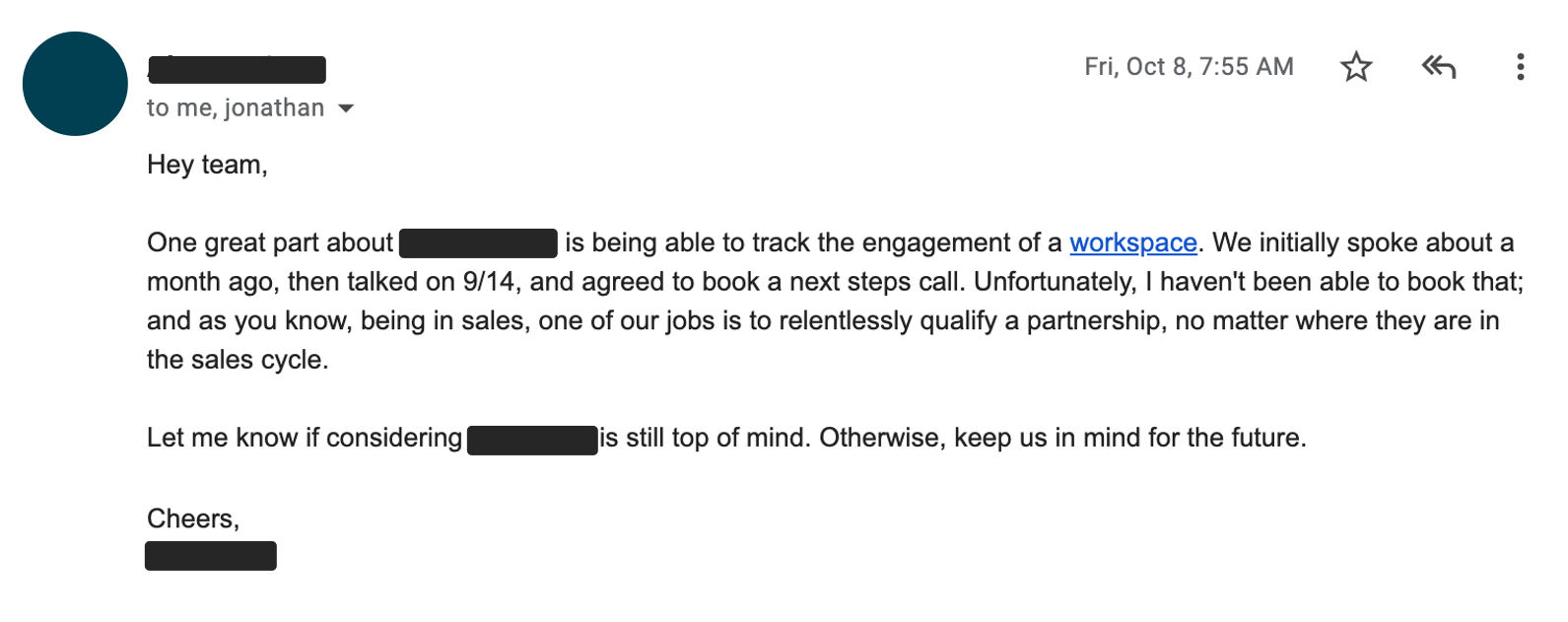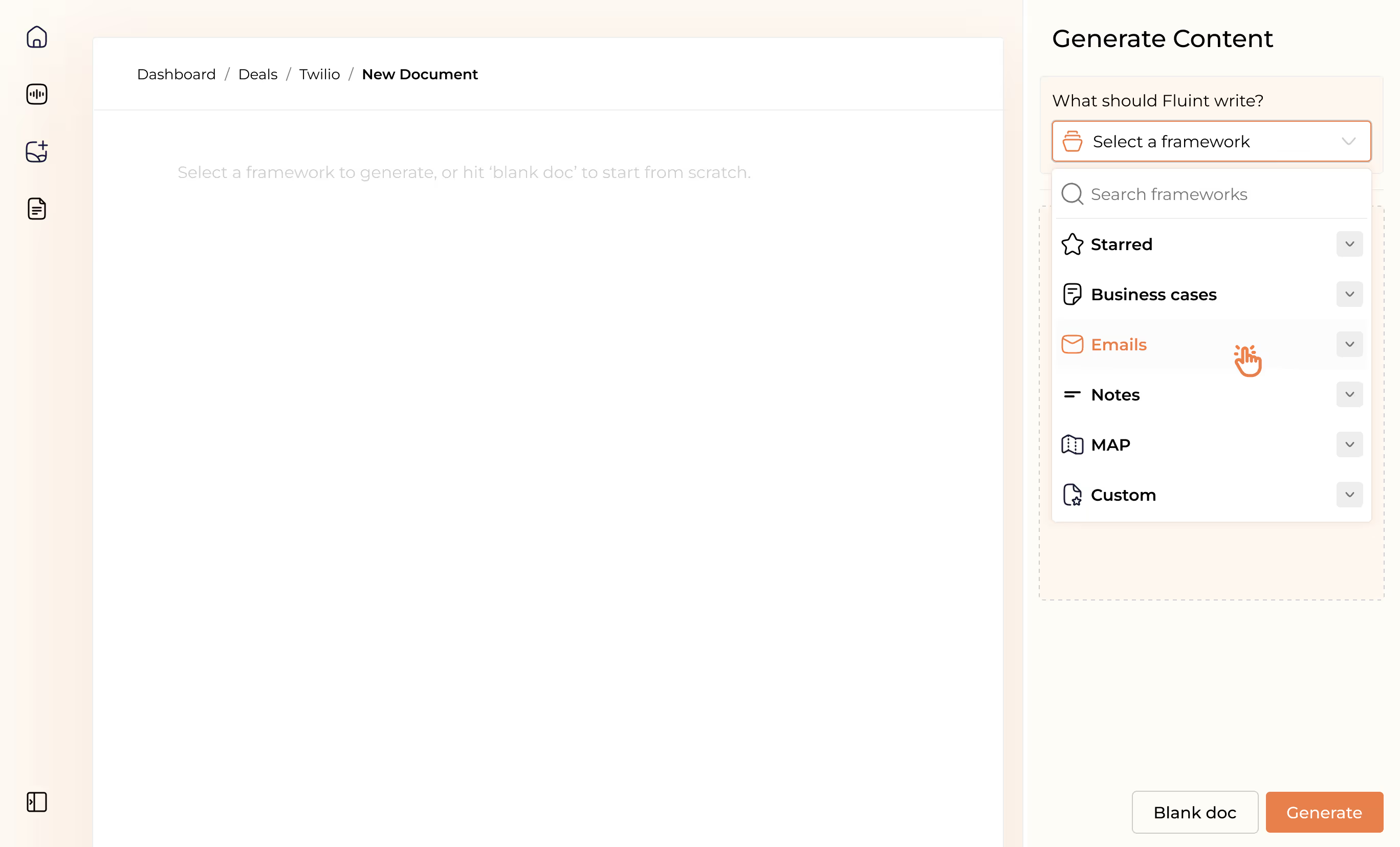The One, Guaranteed Way to Trigger Urgency in B2B Sales


Revenue moves at the slow speed of relationships. Learn how to trigger more buying urgency — the jet fuel for high-performance sales teams — in an authentic way.
Do you know how to draw an owl?

If not, here's a step-by-step guide:
- Draw two ovals and a line.
- Draw the owl.
That's funny because, clearly, a few steps are missing here.
Anyone can do step one, but you can't skip the artistic process and expect to get the end result.
These instructions are ridiculous, but step into a sales team standup during the end of the month, quarter, or year, and you'll hear roughly the same directive: speed up the process.
"We've got two days to close 20% of our revenue goal! Now get after it!"
If you can't make time slow down, your only alternative is to speed up the sale, right?
Urgency: Jet Fuel for High-Performance Sellers
The question, then, is how do you manufacture urgency?
Because if you could manufacture it, it'd be like jet fuel. Just pump a little more into your process whenever sales slow, goals grow, or motivation runs low.
The answers to that question are typically, (1) external pressures, or (2) exploding incentives. Throw one-time discounts, favorable payment terms, and free services at the buyers who are willing to move forward before time expires.

Here's an example that was sent to me this past New Year's Eve.
In the short term, this can work. If you catch a buyer at the point of a final decision, and they just need a reason to sign today instead of next week, they'll be glad to take your offer.
But for most buyers, it's a turnoff that signals your top priority is getting paid.
Luckily, there's another, more relational and reliable way to create urgency. It's the only option guaranteed to work over the long run.
What Drives Your Prospects
We all have internal sources of urgency rooted in the pressures and incentives that matter to us.
Understanding and framing your product around this internal urgency, which already exists inside your buyers, is far more compelling than any external source of motivation.
For example, if you're an executive considering Officevibe (we love Officevibe here), what's going to motivate you?
- The fear of missing out on two months' free subscription, even though you haven't yet discussed rolling out the tool with your HR Director.
- Eliminating the time it takes your team to brainstorm survey questions, build a form, distribute the link, and analyze the results — instead of acting on the info.
- Seeing yourself as one who cares for the mental health and professional success of your team, but maybe, you're not as perceptive as you thought, and waiting to discover if that's true could prove costly.
Notice that:
- Option #1 is external urgency. It's the exploding, end-of-month offer.
- Option #2 is the feature-based sale. It speaks to the individual, but through the standard pain points sellers are taught to listen for during discovery.
- Option #3 is internal urgency. It's the type of unbearable thought we must resolve, ASAP.
Option #1 believes sales moves at the speed of gamesmanship. Option #3 believes sales moves at the speed of relationships. It's the one, enduring source of urgency in sales.
The question to ask ourselves, then, is how do we tap into and help our buyers act on their own, internal sense of urgency?
Step 1: Start by removing your own, internal limiters.
Most cars have governors, which limit how fast you can drive. Jet fuel or not. We all have mental limiters in sales, too.
Building relationships is a process. Much like drawing an owl, you can’t jump from step one to the outcome. But we're graded on and paid for outcomes in sales, so the uncertainty of not knowing whether a particular deal will close is uncomfortable.
That's why we have to start by removing our own, internal limiters. This looks like recognizing that our reward lies in the reality there is no guarantee. Ever. Any deal can fall apart at the 11th hour. All we can bank on is our process of building a relationship.
Therefore, I'd like to propose a new definition of sales to reframe our thinking:
Sales is the generous process of making others better off, by investing time in relationships that may not pay off.
Whether you accept this definition of sales comes down to type of seller you want to be.
Will you be someone who prioritizes relationships? Or one who prioritizes revenue?
Become the first and you’ll get the second. Chose the second, you’ll get neither.
Step 2: Find and focus your follow-up on internal pains.
To find the root of your buyer's urgency, dig deeper into what your prospect's feeling than any qualifying framework suggests. This looks like saying, with genuine concern:
- I'm so sorry you're dealing with this, it sounds frustrating. How are you feeling about it?
- Do you think other team members feel the same way? Do they see what you're seeing?
- How do you think you'd feel if, in another three months, this still hasn't been resolved?
Then, listen to learn what messaging will help sustain your buyer's motivation throughout the buying process.
Next, separate your meeting notes into two categories:
- Functional pains that setup product features.
- Internal pains that create urgency.
If your prospect goes silent late in your sales cycle, use both types to build your follow up:
Hey, {{Prospect Name}},
I was just thinking about what you shared during one of our earlier conversations — how it's been really tough to {{functional pain point}}, which left you feeling like {{source of internal urgency}}.
If you're still working on this, I'd love to share an idea that our customer success team helped develop for you. Would you be up for a quick call this week?
-Your Name
Contrast this with the "always be qualifying" approach in your standard sales framework:

This message largely read to me, "Hey Nate, you agreed to meet with me, but you didn't, so I haven't been able to do my job. Help me [the seller] do my job, because it's not too late for me to cut you [the buyer] loose."
Which of these two approaches is more likely to incite action?
Step 3: Segment your pipeline by "seasons" of pain.
All buyers have a different set of internal pains, no matter how similar your Ideal Customer Profile may suggest they are.
Therefore, buyers facing the same functional pains will move at different speeds. Instead of expecting each deal to move at the pace of your average sales cycle, segment your buyers into different "seasons" of internal pain:
- Spring: Slowly awakening to the full reality of the problem. A desire to do something is blooming, but it's still early.
- Summer: A desire to fix the problem is heating up. The cost of inaction is creating small fires around the office.
- Fall: Time is running out. If the problem isn't fixed soon, a cold winter with consequences will set in.
Pick out three deals from your pipeline, and consider them side-by-side. Even if you've selected deals from the same stage, are they in different seasons? If so, do their close dates reflect their season? Or, the time elapsed since your first meeting?
This comparison should create clarity. Seasons will show you if they're a:
- Fall Buyer: Someone who needs one month to run through a six-month sales cycle. Your risk is when you're not keeping pace with them, over-qualifying or pitching too hard. (I once started a meeting by pitching too hard, and the buyer cut me off and said, "Nate, we're ready to go, we just need the contract.")
- Summer Buyer: Someone who's in the middle of the bell curve. An end-of-month offer may force their hand, but we wary. Doing so too early, before they're on the brink of Fall, means you’re no longer moving at the speed of relationships. This introduces resentment or the (negative) fear of missing out.
- Spring Buyer: Someone who needs help unearthing the full extent of their problem. They need to own an uncomfortable reality they've been pushing aside. While they may need twice the typical cycle time to close, by moving at their pace, you'll avoid cutting off a perfectly healthy piece of your pipeline that just needs time.
Step 4: Clarify the consequences of inaction.
If you meet someone in "Spring," ask, "How long would you say this has been a problem?" If it's a considerable amount of time, you'll need to help your buyer see reality as it actually is.
The emotional exhaustion of enduring a longstanding problem can create a quiet apathy. Mental burnout makes doing nothing a perfectly attractive option.
So if you're going to be the one to help this buyer, clarifying their reality will allow you to move the conversation toward the value you can create with them. Ask questions like:
- If your leadership team discovered this still hasn't been solved, what would they say?
- That's definitely a problem for the company, but how has this impacted you personally?
- A really similar scenario played out {{reference case study X}}. Could your situation be similar?
Step 5: Rate your buyer's confidence from 1 - 10 after each meeting.
Sales leaders often coach their reps to lead with confidence. It sounds something like, “If you’re not showing up confident, why would your buyer feel confident?”
There’s truth there, confidence is a key ingredient to a sale. But it's most helpful to flip this into a question and ask, "What's undermining your buyer’s confidence?"
Typically, it’s not a sales rep who questions whether or not they can help the buyer. In fact, seriously considering the possibility there’s no opportunity to work together, by transparently laying out all your concerns so the buyer feels they've exhausted all potential obstacles, increases their confidence.
A practical way to determine if you've increased your buyer's confidence is to end your meetings by asking:
"How confident do you feel {{product}} can help you address {{pain}} on a scale of 1 - 10?"
Followed up with:
"Is there something you feel you'd need to see or know, to feel a 10/10 confident?
Noting this number after each meeting will determine if your buyer's confidence is going up, or down.
Step 6: Optimize sales touch points for trust.
A key element of buying confidence is trust, and the difference in high- and low-trust relationships is material.
Inside of a trusting relationship, you can say the wrong thing and people will still feel you're coming from a place of good intent. Without trust, you can be precise in your words, and a buyer will still misinterpret or misrepresent you to their team.
Here's how to optimize touch points in your sales process for trust:
- Talk straight. Preface sensitive statements or questions by sharing your intent. "I'm asking this because..." This helps you avoid any resemblance of "fake" behaviors, like withholding information, ingratiation, or spin.
- Tackle reality head-on. If you spot and choose to ignore a potentially-sticky problem upfront, you'll end up paying a huge tax down the road. It'll require far more time to unwind doubts when someone feels key information or real issues were buried early in the relationship.
- Be genuinely bold. We all want to avoid hustling our buyers, which means we may hold back a question or statement for fear of appearing manipulative. So ask, "If my buyer knew what I already know about we help our customers, would they be glad they did what I'm asking them?"
- Deliver on commitments. Coming through on small things creates trust that you'll follow through on the big things too. If you say, "I'll get this over to before the end of today," then do it. Over time, these interactions will set the tone for your buyer's entire customer relationship.
Pick a few of these steps and try them out this week. You'll see how triggering buying urgency in an authentic way is both the short- and long-term accelerator your team has been looking for.
FAQ's on:
Why stop now?
You’re on a roll. Keep reading related write-up’s:
Draft with one click, go from DIY, to done-with-you AI
Get an executive-ready business case in seconds, built with your buyer's words and our AI.

Meet the sellers simplifying complex deals
Loved by top performers from 500+ companies with over $250M in closed-won revenue, across 19,900 deals managed with Fluint

Now getting more call transcripts into the tool so I can do more of that 1-click goodness.



The buying team literally skipped entire steps in the decision process after seeing our champion lay out the value for them.


Which is what Fluint lets me do: enable my champions, by making it easy for them to sell what matters to them and impacts their role.








